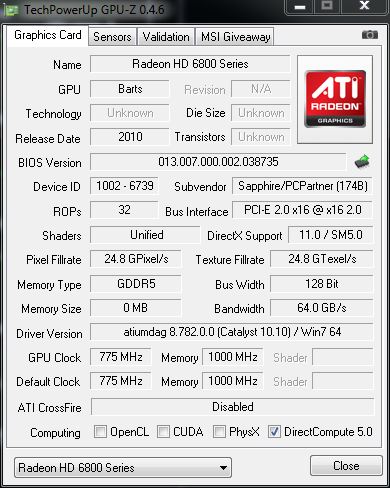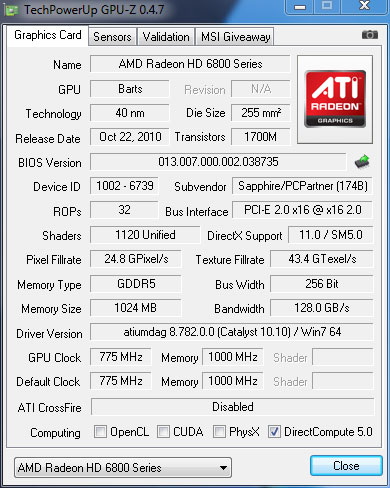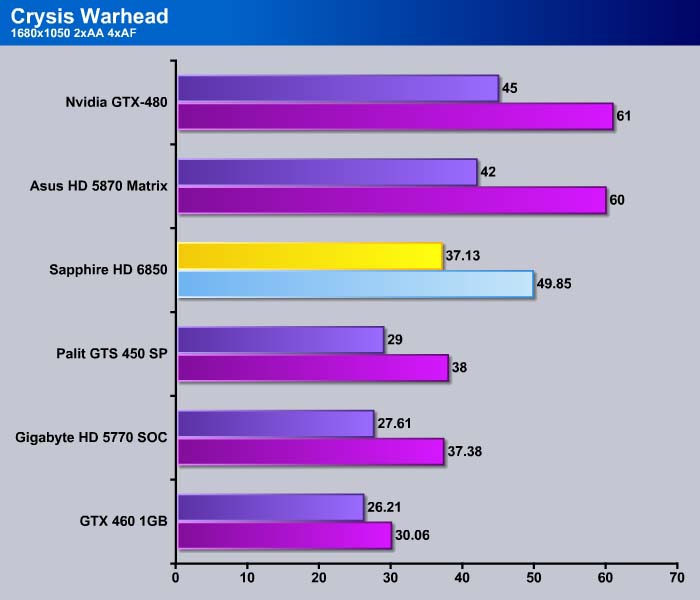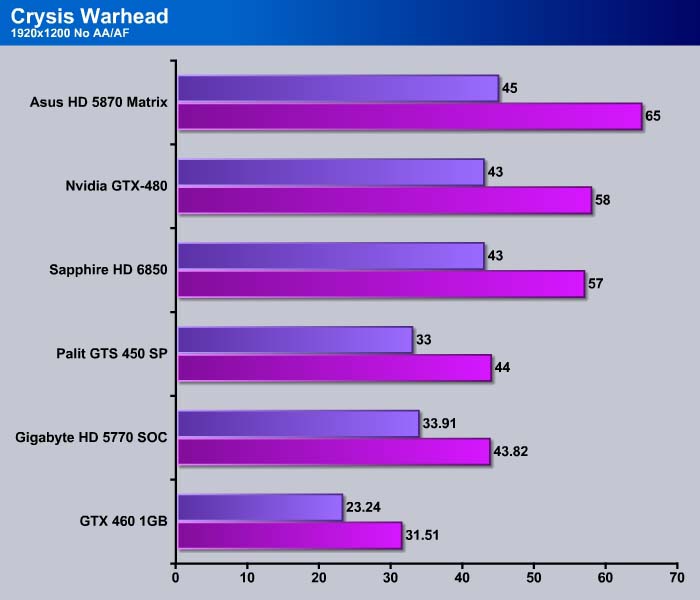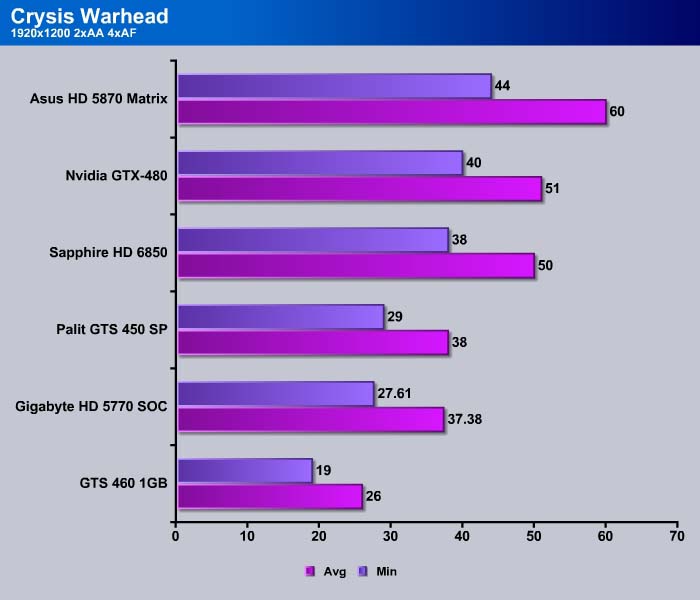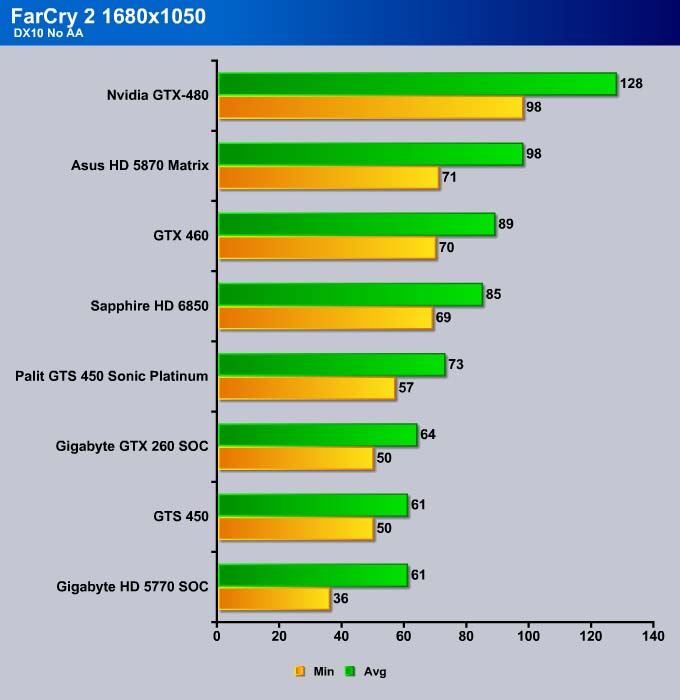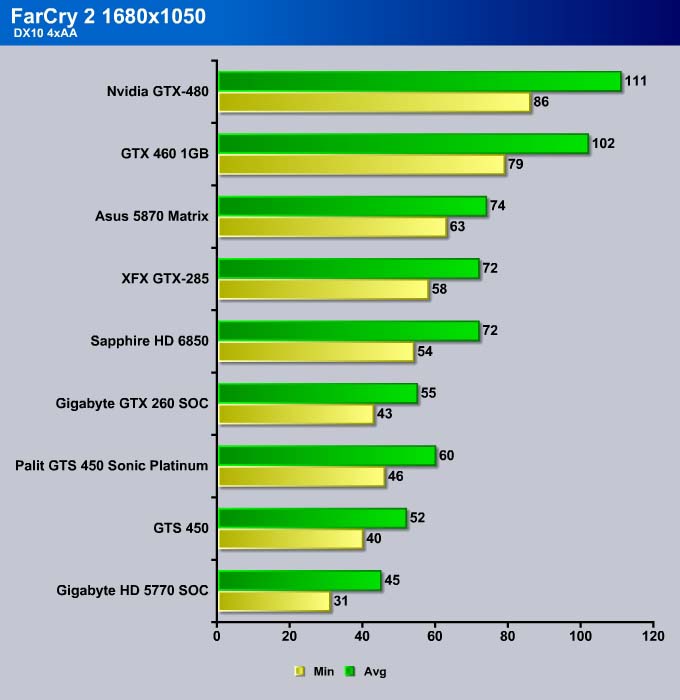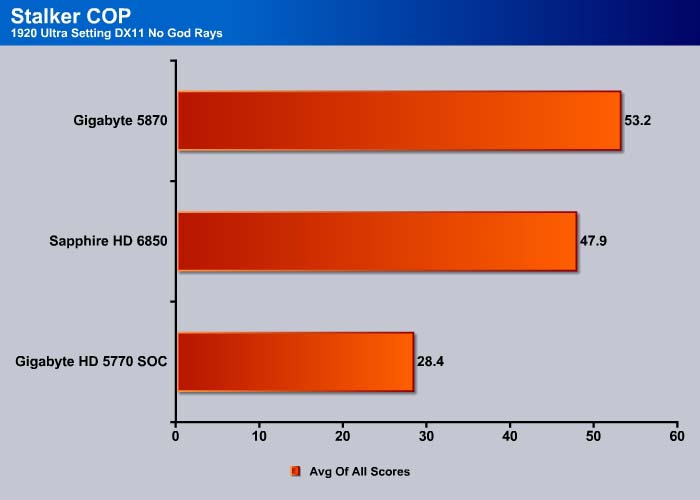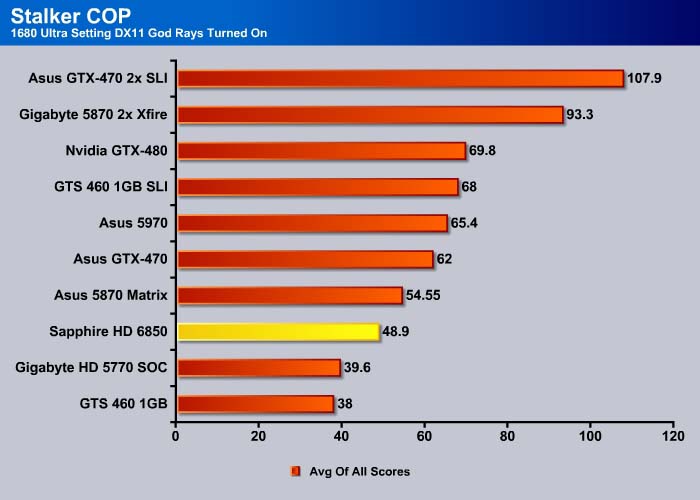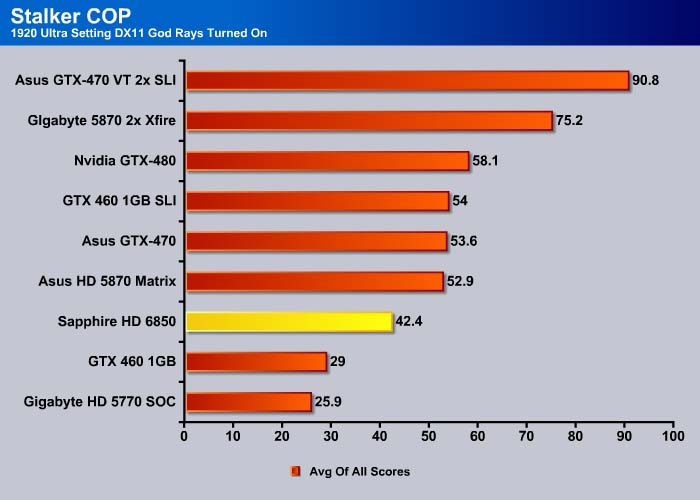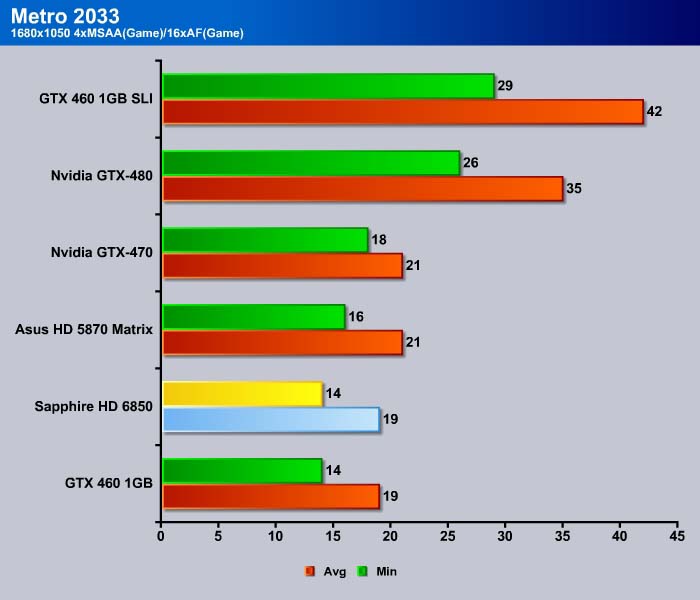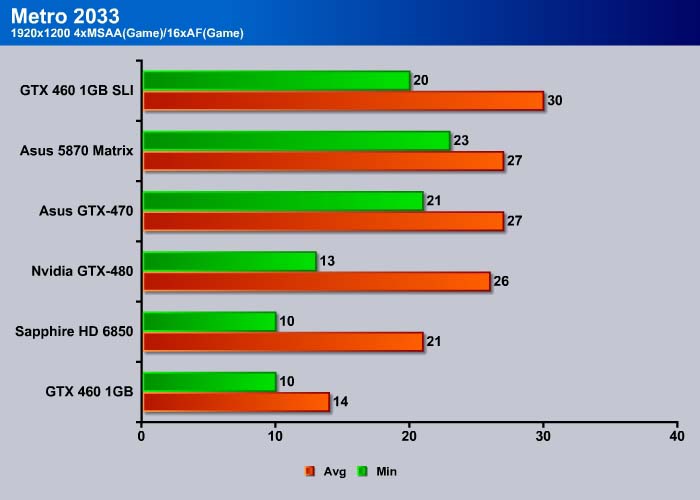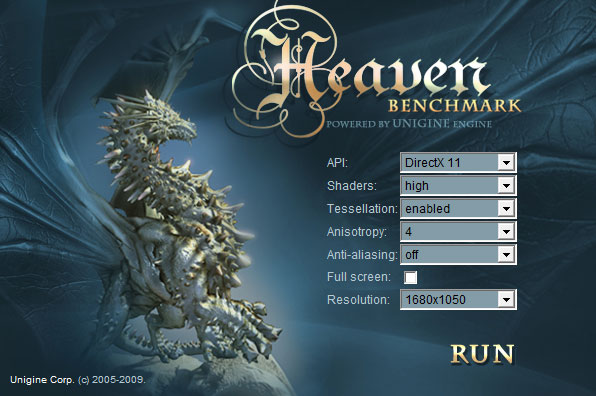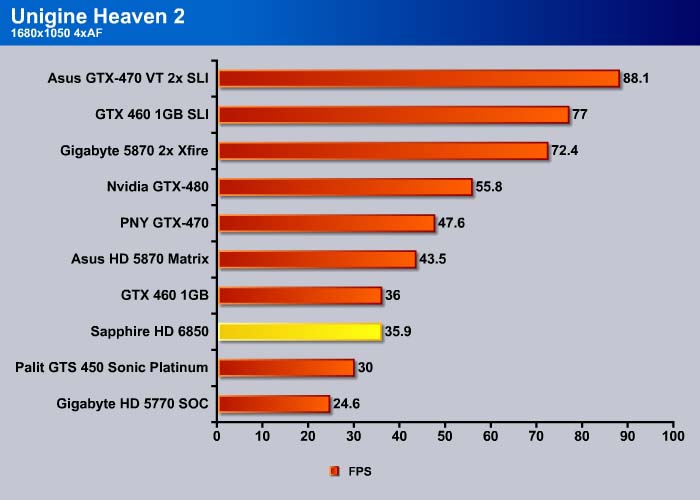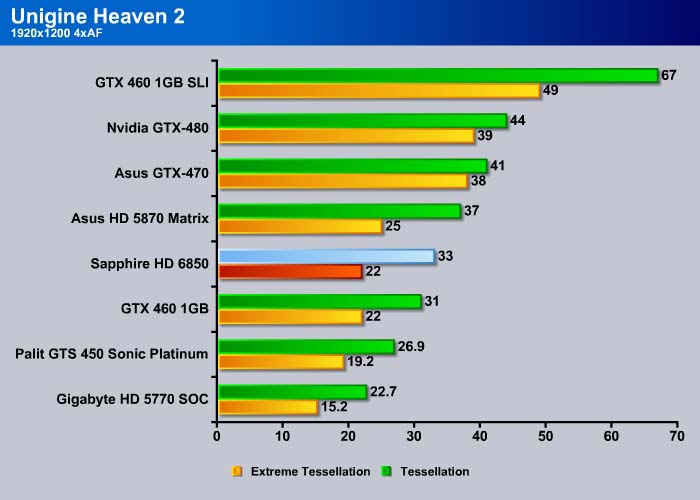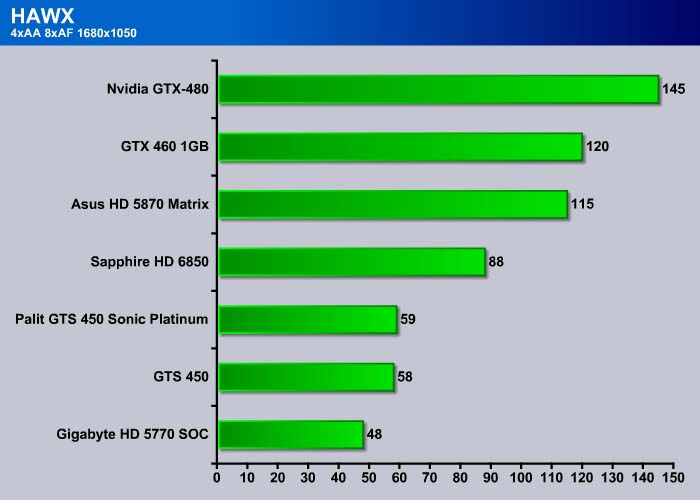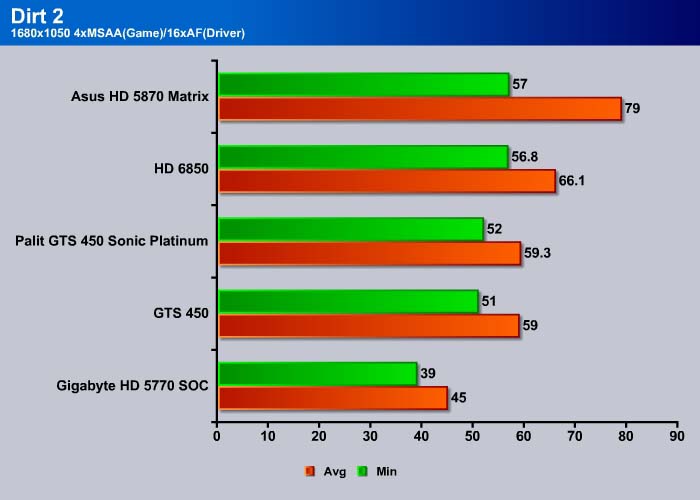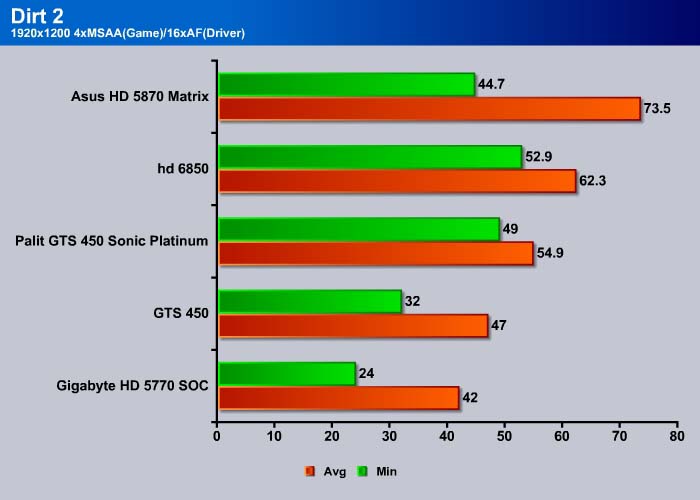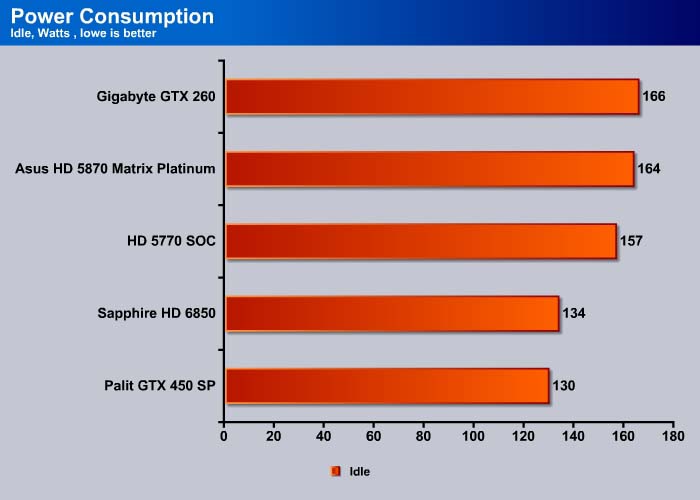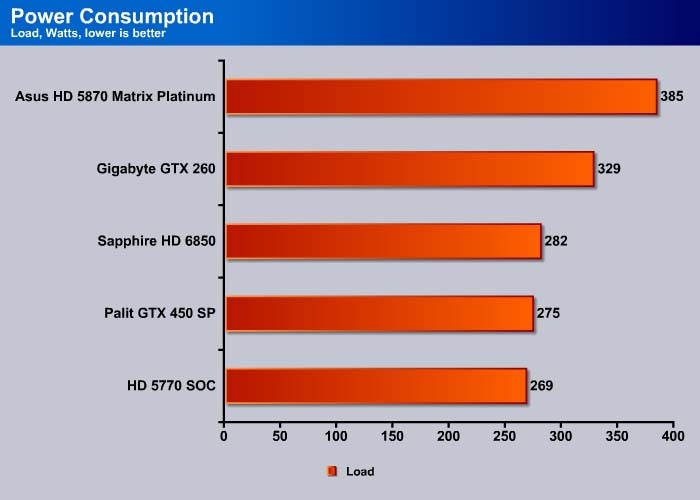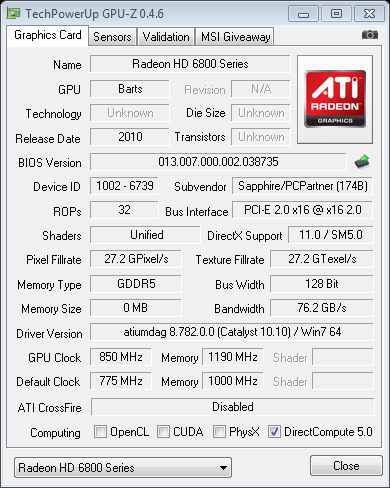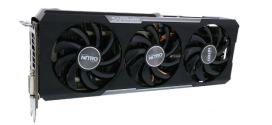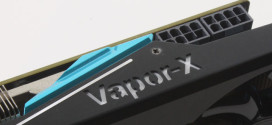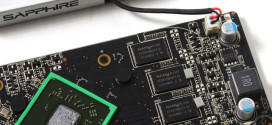Sapphier HD 6850 is the latest mainstream graphics card with AMD competing against Nvidia GTX 460. With good performance at 1920×1080, low power consumption, and low heat-ouput, it may just be the card to beat…
INTRODUCTION
A year has passed since the world saw the first DirectX 11 cards. AMD’s first DX11 card, the HD5870 (codenamed Cypress), was introduced on September 2009. The card held the top spot for almost six months, until Nvidia released the GTX 480. Like CPUs, graphics cards often go through a cycle that mimics Moore’s Law. Every 12 to 18 months, it is expected that a new generation of cards will arrive on the market. Every three to five years, we expect to see a major architecture update. So it’s no surprise that a year after the first DirectX 11 card came out, AMD is releasing the next generation of graphics cards.

The HD6000 series is AMD’s newest product line. First up in the series are the HD6850 and HD6870, both of which target at the mainstream market. Our founder, Bjorn Endre, did an excellent job introducing the technical aspect of the new cards; we suggest you read the article to get some background information. In short, since the HD6850 is more like an upgrade to the existing architecture instead of a new design, the underlying architecture has not changed. Instead, the biggest improvement on the HD6000 series is the shader unit: instead of a 4 simple + 1 complex arrangement, it now has 4 medium complexity arrangements. This frees up some die-size (which saves cost and also heat output), and at the same time allows the GPU to make more efficient calculations and hence better performance.
For those wondering why AMD started the HD6000 series with the mainstream instead of high-end card, though the top of the line products often steal the spotlight, it is actually the mainstream products that sell the most. Not everyone can afford a $500 graphics card, or the hardware required to fully take advantage of such a card’s power. Instead, the majority of consumers happily settle for the mainstream cards at $200 range where it offers an excellent performance at resolution up to 1920×1200 with enough eye-candies turned on.
AMD’s HD5000 series left a void in this price bracket, and we are happy to see at least one card in the latest generation that fills this gap. In addition, the HD6850 also replaces the HD5850 and HD5830. Readers can check out Bjorn’s review for more detail on the performance of the HD 6870.
While the HD 6850 that we have here today is designed to compete against the Nvidia GTX 460 768 MB and the HD 6870 is competing against the GTX 460 1GB version, the recent price drop from NVIDIA puts the GTX 460 1GB directly against the HD 6850. The HD 6850 has suggested retail price of $179 and Nvidia has recently dropped the pricing on the GTX 460 to 1GB to $199.99. Nvidia also drops the price of the GTX 470 to $259.99, essentially putting it up against the HD 6870. Looks like the consumers will reap the benefit of the price war.
NOTE: We discovered that our review sample was shipped with the GPU that contains 1120 shader unit instead of the 960 shader unit. As a result, the performance from our review sample is not going to accurately represent the HD 6850 with 960 shader unit. We are working with Sapphire to obtain a retail version of the card and will redo the test to accurately reflect the HD 6850’s performane when they provide us with a new sample.
AMD has informed us that all of the retail HD 6850 should only come with 960 shader unit and for those who may have receive a card with 1120 shader unit, you should contact the vendor or the manufacturers for a replacement. Check our forum for more information as we bring you updated information.
sapphire HD6850
Because of a shader refinement, we can see the HD6850 only has 960 shader units, much fewer than the HD5830’s 1120 shader units or the HD5850’s 1440 shader units. In addition, the core clockspeed on the HD 6850 is running at 775 MHz, which is 50MHz higher than the HD 5850 but 25MHz lower than the HD 5830. The memory speed has been reduced slightly to 900 MHz, instead of the 1,000 MHz found on the HD5830 and HD5850. The card still maintains the 256-bit memory bus width, 32 ROPs, and 1 GB of GDDR5. Manufacturers could potentially put 2GB of GDDR5 on the card, but our review sample only comes with 1GB.
| GPU | Radeon HD 5830 | Radeon HD 5850 |
Radeon HD 5870 |
Radeon HD 5970 |
Radeon HD 6850 | Radeon HD 6870 |
|---|---|---|---|---|---|---|
| Die Size | 334 | 334 | 334 | 2×334 | 230 | 255 |
| Shader units | 1120 | 1440 | 1600 | 2x 1600 | 960 | 1120 |
| Texture Units | 56 | 72 | 80 | 2×80 | 56 | 56 |
| ROPs | 32 | 32 | 32 | 2x 32 | 32 | 32 |
| GPU | Cypress LE | Cypress | Cypress | 2x Cypress | Barts Pro | Barts XT |
| Transistors | 2154M | 2154M | 2154M | 2x 2154M | 2000M | 1700M |
| Memory Size | 1024 MB | 1024 MB | 1024 MB | 2x 1024 MB | 1024MB | 1024MB |
| Memory Bus Width | 256 bit | 256 bit | 256 bit | 2x 256 bit | 256 bit | 256 bit |
| Core Clock | 800 MHz | 725 MHz | 850 MHz | 725 MHz | 775 MHz | 900 MHz |
| Memory Clock | 1000 MHz | 1000 MHz | 1200 MHz | 1000 MHz | 900 MHz | 1050 MHz |
| Price | $299 | $399 | $599 | $179 | $230 |
The smaller die allows AMD to shed a few more watts of power consumption. The HD6850 has a rated idle power consumption of 20W and maximum load power consumption of less than 150W. In comparison, the HD5830 consumes 25W idle and 175W load, and the HD5850 consumes 27W idle and 151W. In fact, the HD6850 only requires only a single 6-pin PCIE power connector for additional power, making it an excellent choice for anyone with an older PSU that only has one 6-pin PCIE power adapter. Nvidia’s GTX 460, in comparison, requires two 6-pin connectors.
For a mainstream card, the HD6850 is surprisingly light and small. As we can see from the picture above, it just a tad longer than the HD5770, at 8.5 inches long (22 cm), making it a perfect choice for the small form factor system like the Shuttle. Sapphire opts to use their own heatsink instead of the reference design. Two copper heatpipes extend out of the GPU, conducting the heat away from the GPU to the heatsink sitting above the card. A single 80mm axial fan as oppose to the radial fan found on the reference design sits above the heatsink to keep it running cool. This is one of the quietest and coolest midrange cards we have ever tested.
For displays, the Saphire HD 6850 comes with two Dual-link DVI ports, an HDMI port, and a DisplayPort. While the reference card comes with two mini-DisplayPort, we are glad to see Sapphire’s decision to include the full size port so users do not need to use an adapter. There is one drawback with lacking of the second DisplayPort. The HD 6850 supports up to 6 simultaneous displays when using two DisplayPort 1.2 so lacking the second DisplayPort would limits numbers of maximum displays supported.
Sapphire does not include many accessories with the card. It only comes with a CrossFire bridge, DVI-to-VGA adapter, an HDMI cable, and a PCI-E power adapter. The PCI-E power adapter included is rather differently: normally, cards require two 4-pin molex inputs but the adapter that is included only needs a single 4-pin molex, just another sign of how frugal the card is in terms of power consumption. The box does not come with a driver CD, but we think this is mostly because our sample arrived before the release date, so we do expect the retail version will come with a driver disk.
Lately, we have seen graphics card companies require customers who purchased the card to register their product for extended warranty or special promotions. We really do not like the requirement of registration, especially for the warranty purpose. While not bundled with any games, the card does have some promotions called the “Sapphire Select Club (SSC),” which allows users to download 5 free softwares per year from the list of Free Promotions. The promotions include game titles and applications. According to the site, there may even be gift cards and other promotions. When we checked the site, we did not find the list of the software titles available . At the least, we are glad that Sapphire does not require customers to register for the full warranty, and the HD6850 is under warranty for 2 years, slightly shorter than other manufacturers.
GPU-z
Nvidia has enjoyed a lead in the 3D gaming market with their 3D Vision technology. AMD is finally bringing 3D gaming to their cards with the HD6000 series. The HD3D, as the company calls it, includes support for Blu-ray in 3D, and others. In addition, the HD6000 series will also support updated Universal Video Decoder 3 (UVD3), which adds support for hardware-based decoding for the H.264 and VC-1 video format. This adds to the current UVD2.2’s dual video stream decoding and Picture-in-Picture mode. AMD also upgraded the HDMI to version 1.4a, which adds support for the two mandatory 3-D format (Side-by-Side Horizontal & Top-and-Bottom), which was dropped from the original 1.4 version.
NOTE: We discovered that our review sample was shipped with the GPU that contains 1120 shader unit instead of the 960 shader unit. As a result, the performance from our review sample is not going to accurately represent the HD 6850 with 960 shader unit. AMD has informed us that all of the retail HD 6850 should only come with 960 shader unit and for those who may have receive a card with 1120 shader unit, you should contact the vendor or the manufacturers for a replacement. Check our forum for more information as we bring you updated information.
TESTING & METHODOLOGY
To test the Sapphire HD6850 we did a fresh load of Windows 7 Ultimate, applied all the updates we could find, installed the latest motherboard drivers for the Gigabyte EX58-UD4P, updated the BIOS, and loaded our test suite. We didn’t load graphic drivers because we wanted to pause to clone the HD with the fresh load of Windows 7 without graphic drivers. That way we have a complete OS load with testing suite and it’s not contaminated with GPU drivers. Should we need to switch GPU’s or run CrossFire, later all we have to do is clone our drive and install GPU drivers and we are good to go.
We ran each test a total of 3 times and report the average here. In the case of a screenshot of a benchmark we ran the benchmark 3 times, tossed out the high and low and post the median result from the benchmark. Any erroneous results were discarded and the test was rerun.
Test Rig
| Test Rig “Quadzilla” |
|
| Case Type | None |
| CPU | Intel Core I7 920 |
| Motherboard | Gigabyte EX58-UD4P |
| Ram | Kingstone HyperX 1600 |
| CPU Cooler | Prolimatech Megahalem |
| Hard Drives | Seagate 7200.11 1.5 TB |
| Optical | None |
| GPU | Gigabyte HD 5770 Super Overclock Asus HD 5870 Matrix Platinum GTX 460 1GB Palit GTS 450 Sonic Platinum Drivers for Nvidia GPU’s 260.89 Drivers for ATI GPU’s 10.9 (beta) |
| Case Fans | 120mm Fan cooling the mosfet CPU area |
| Docking Stations | None |
| Testing PSU | Cooler Master UCP 900W |
| Legacy | None |
| Mouse | Microsoft Intellimouse |
| Keyboard | Logitech Keyboard |
| Speakers | None |
Synthetic Benchmarks & Games
| Synthetic Benchmarks & Games | |
| 3DMark Vantage | |
| World In Conflict Benchmark | |
| Crysis v. 1.2 | |
| Dirt 2 | |
| FarCry 2 | |
| Stalker COP | |
| Crysis Warhead | |
| Unigine Heaven v.2.0 | |
| FurMark | |
You can see we are indeed all over the map, DX9, DX10, DX11, and Tessellation. We wanted as wide a representative sample as possible in the time available.
Crysis v. 1.21
Crysis was the most highly anticipated game to hit the market in the last several years. Crysis is based on the CryENGINE™ 2 developed by Crytek. The CryENGINE™ 2 offers real time editing, bump mapping, dynamic lights, network system, integrated physics system, shaders, shadows, and a dynamic music system, just to name a few of the state-of-the-art features that are incorporated into Crysis. As one might expect with this number of features, the game is extremely demanding of system resources, especially the GPU. We expect Crysis to be a primary gaming benchmark for many years to come.
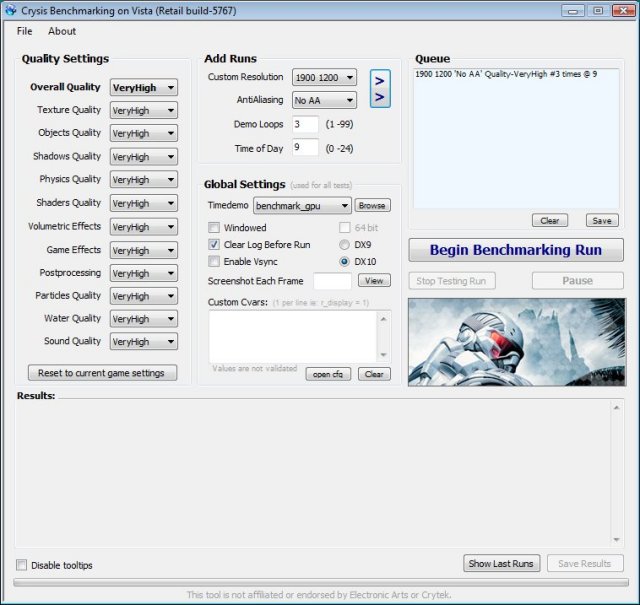
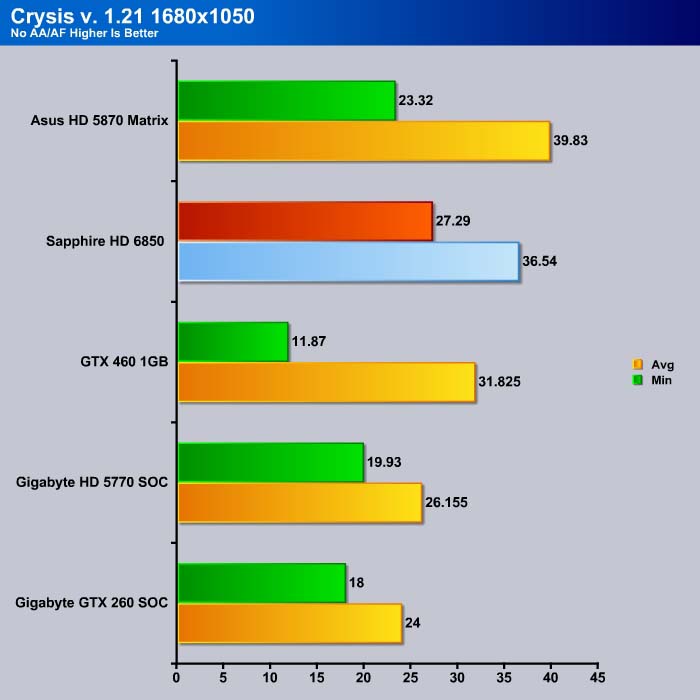
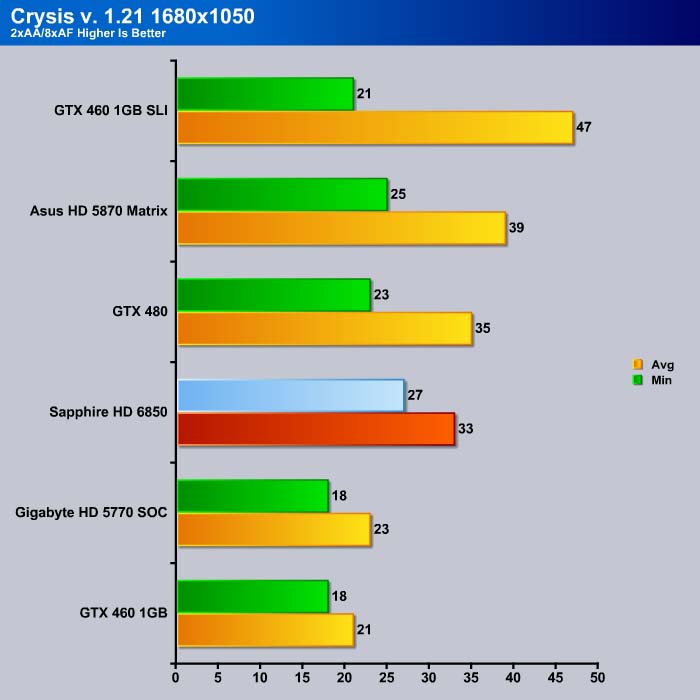
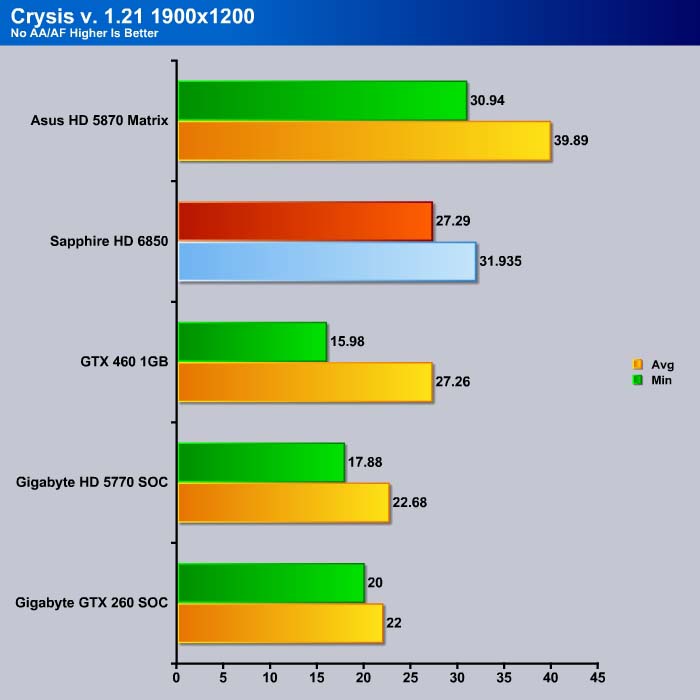
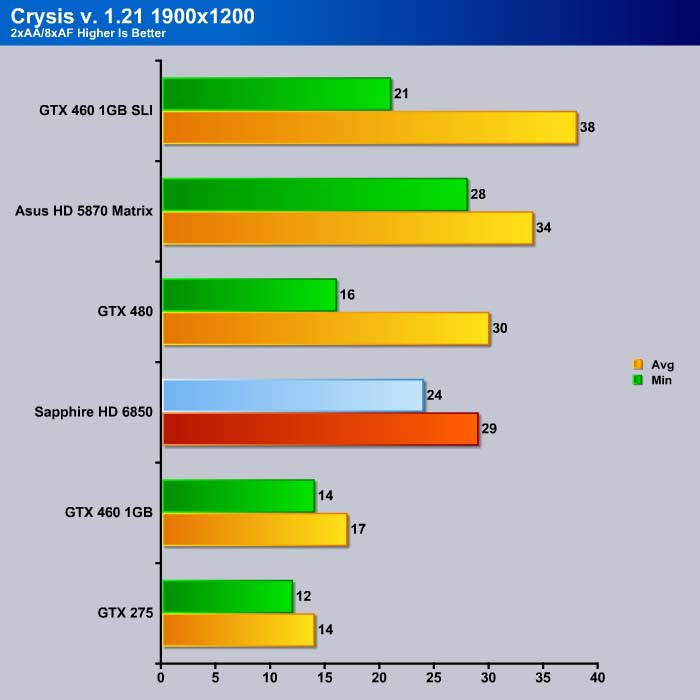
CRYSIS WARHEAD
Crysis Warhead is the much anticipated standalone expansion pack to Crysis, featuring an updated CryENGINE™ 2 with better optimization. It was one of the most anticipated titles of 2008.

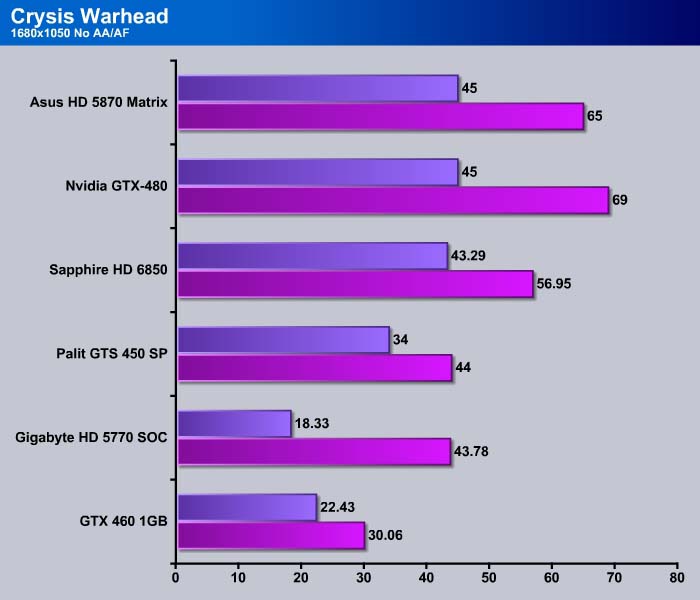
At 1680×1050, the HD6850 maintains a substantial lead over the GTX 460. Surprisingly, our overclocked Palit GTS 450 Sonic Platinum actually out-performs the GTX 460 in Crysis Warhead. We did not have time to re-test the GTX 460, so we simply reported the result.
Again, we can see that the HD6850 is able to maintain 85% of the HD 5870’s average frame rate. If we look at the minimal frame rate, we can see both the HD5870 and HD6850 actually yield very comparable results.
The performance difference between current and last generation AMD cards is more visible when we enable the AA and AF. Still, the HD6850 is able to maintain 80% of the HD5870’s performance.
As we turn up the resolution, we continue to see the HD6850 leap ahead of current Nvidia mid-range graphics card.
Far Cry 2
Far Cry 2, released in October 2008 by Ubisoft, was one of the most anticipated titles of the year. It’s an engaging state-of-the-art First Person Shooter set in an un-named African country. Caught between two rival factions, you’re sent to take out “The Jackal”. Far Cry 2 ships with a full featured benchmark utility and it is one of the most well designed, well thought out game benchmarks we’ve ever seen. One big difference between this benchmark and others is that it leaves the game’s AI (Artificial Intelligence) running while the benchmark is being performed.
 The Settings we use for benchmarking FarCry 2
The Settings we use for benchmarking FarCry 2
Unfortunately, the HD6850 does not score a home run in every game. Here, the GTX 460 comes alive and edges out the HD6850.
Nvidia cards often come out ahead of AMD cards in Far Cry 2, so it is no surprise that when we enabled the AA, we see an even bigger performance difference between the GTX 460 and the HD6850. Here the GTX 460 even comes in ahead of the high performance HD5870.
Again, if we only compare difference between the AMD cards, we can see the HD6850 still maintains 85% of the performance of the HD5870, and almost double the performance of the HD5770.
At higher resolution, we can see the HD6850 is able to offer a good performance lead over the GTS 450 (which is selling at $80 cheaper). Even when we compare against the more expensive overclocked GTS 450 Sonic Platinum (selling at $160), the HD6850 is clearly the better choice, in spite of its higher price tag.
When we turn up the eye-candies, we can see the HD6850 comes right between the GTS 450 and the GTX 460. Here we can see that while the GTX 460 shows a commanding lead at 1680×1050, it falls behind the HD5870 at 1920×1080 when we turn up the visual effects.
Though still not able to beat the GTX 460, the HD6850 shows a respectable result of 67 average FPS and 49 minimum FPS, enough to offer smooth game play with plenty of visual effects.
S.T.A.L.K.E.R.: CALL OF PRIPYAT
Call of Pripyat is the latest addition to the S.T.A.L.K.E.R. franchise. S.T.A.L.K.E.R. has long been considered the thinking man’s shooter, because it gives the player many different ways of completing the objectives. The game includes new advanced DirectX 11 effects as well as the continuation of the story from the previous games.

Let’s start by compare the AMD cards when we took the God Rays (Sun Shafts) off the equation.
Looks like the AMD cards scaled fairly well at this resolution. The HD 6870 offers 67% increase over the HD 5770 and the HD 5870 offers 26% increase over the HD 5770.
At 1920×1080, the HD 6850 continues to offer 68% increase over the HD 5770 but the performance difference between the HD 5870 and 6850 has been narrowed to only 11%. The more efficient shader unit on the HD 6850 probably helps out the extra performance gain.
As we turn up the resolution, we can see the HD5870 comes in 25% ahead of the HD6850 because of its many shader units. However, the HD6850 is definitely a superior card in this test, with a 46% performance gain over the GTX 460.
Metro 2033
Metro 2033 is an action-oriented video game with a combination of survival horror, and first-person shooter elements. The game is based on the novel Metro 2033 by Russian author Dmitry Glukhovsky.
The enemies that the player encounters range from human renegades to giant mutated rats and even paranormal forces known only as “The Dark Ones”. Players frequently have to defend themselves with makeshift combination’s of different weapons, e.g a revolver with a sniper scope attached.
Ammunition is also scarce, and the more rare Military Grade bullets are used as currency (to purchase supplies and guns), or in combat as a last resort, giving an added damage boost, forcing the player to hoard supplies.
The game lacks a health meter, relying on audible heart rate and blood spatters to show the player what state they are in and how much damage was done. A gas mask must be worn at all times when exploring the surface due to the harsh air and radiation. There is no on-screen indicator to tell how long the player has until the gas mask’s filters begin to fail, so players must set a wrist watch, and continue to check it every time they wish to know how long they have until their oxygen runs out, requiring the player to replace the filter (found throughout the game). The gas mask also indicates damage in the form of visible cracks, warning the player when a new mask is needed. The game does feature traditional HUD elements, however, such as an ammunition indicator and a list of how many gas mask filters and adrenaline shots remain.
Metro 2033 is one of the most demanding games for the GPUs on the market. The HD6850 and the GTX 460 are neck to neck in Metro 2033 at 1680×1050.
However, the HD6850 pulls ahead of the GTX 460 when we crank up the resolution.
Unigine Heaven 2.0
Unigine Heaven is a benchmark program based on Unigine Corp’s latest engine, Unigine. The engine features DirectX 11, Hardware tessellation, DirectCompute, and Shader Model 5.0. All of these new technologies combined with the ability to run each card through the same exact test means this benchmark should be in our arsenal for a long time.
The settings we used in Unigine Heaven
This is another instance where the HD6850 and the GTX 460 are performing virtually identical to each other at 1680×1050.
As we crank up the resolution, we see the HD6850 pulls ahead of the GTX 460, with 2 extra frames under normal tessellation setting. When we have extreme tessellation enabled, both the GTX 460 and the HD6850 turn in 22 frames.
3DMark Vantage
For complete information on 3DMark Vantage Please follow this Link:
www.futuremark.com/benchmarks/3dmarkvantage/features/
The newest video benchmark from the gang at Futuremark. This utility is still a synthetic benchmark, but one that more closely reflects real world gaming performance. While it is not a perfect replacement for actual game benchmarks, it has its uses. We tested our cards at the ‘Performance’ setting.
3DMark Vantage places the HD6850 ahead of the GTX 460, with 2259 higher points. The card even scored 864 more points than the GTX 470.
HawX
The story begins in the year 2012. As the era of the nation–state draws quickly to a close, the rules of warfare evolve even more rapidly. More and more nations become increasingly dependent on private military companies (PMCs), elite mercenaries with a lax view of the law. The Reykjavik Accords further legitimize their existence by authorizing their right to serve in every aspect of military operations. While the benefits of such PMCs are apparent, growing concerns surrounding giving them too much power begin to mount.
Tom Clancy‘s HAWX is the first air combat game set in the world–renowned Tom Clancy‘s video game universe. Cutting–edge technology, devastating firepower, and intense dogfights bestow this new title a deserving place in the prestigious Tom Clancy franchise. Soon, flying at Mach 3 becomes a right, not a privilege.
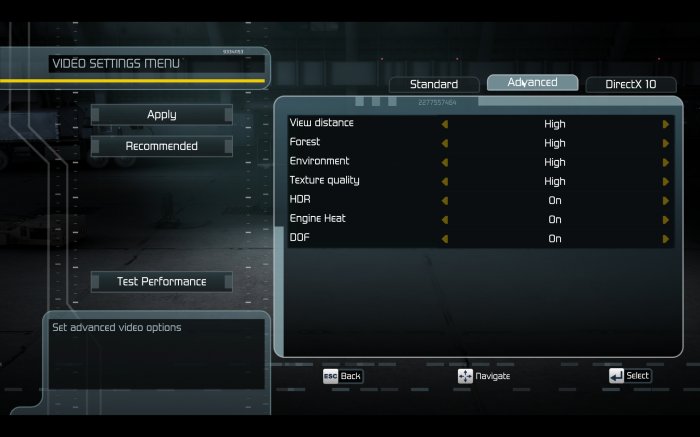
HAWX is another game where Nvidia cards often have better performance. Here the HD6850 scored 88 points, higher than the GTX 450’s 58 points but lower than the GTX 460’s 120 points.
At 1920×1200, the performance gap between the HD6850 and the GTX 460 has been narrowed. While the GTX 460 still scored higher points, the HD6850 is able to narrow that gap with a score of 91 points. The HD5870 scored 18 points higher than the HD6850, and came in ahead of the GTX 460.
Dirt 2
Colin McRae: Dirt 2 (known as Dirt 2 outside Europe and stylized, DiRT) is a racing game released in September 2009, and is the sequel to Colin McRae: Dirt. This is the first game in the McRae series since McRae’s death in 2007. It was announced on 19 November 2008 and features Ken Block, Travis Pastrana, Tanner Foust, and Dave Mirra. The game includes many new race-events, including stadium events. Along with the player, an RV travels from one event to another, and serves as ‘headquarters’ for the player. It features a roster of contemporary off-road events, taking players to diverse and challenging real-world environments. The game takes place across four continents: Asia, Europe, Africa and North America. The game includes five different event types: Rally, Rallycross, ‘Trailblazer,’ ‘Land Rush’ and ‘Raid.’ The World Tour mode sees players competing in multi-car and solo races at new locations, and also includes a new multiplayer mode.
Colin McRae: Dirt is the first PC video game to use Blue Ripple Sound’s Rapture3D sound engine by default.
A demo of the game was released on the PlayStation Store and Xbox Live Marketplace on 20 August 2009. The demo appeared for the PC on 29 November 2009; it features the same content as the console demo with the addition of higher graphic settings and a benchmark tool.
Dirt 2 is our last set of benchmarks where we look at the performance scaling of the AMD cards for DirectX 11. Here we can see the HD6850 still maintains 80~85% of the HD5870’s performance.
POWER CONSUMPTION
To get our power consumption numbers we plugged in our Kill A Watt power measurement device and took the Idle reading at the desktop during our temperature readings. We left it at the desktop for about 15 minutes and took the idle reading. Then we ran Furmark for 10 minutes and recorded the highest power usage.
Here we can clearly see how the shader refinement reduces the power consumption on the HD 6000 series of cards. The HD6850 consumes only 134W under idle, which is 23W lower than the HD5770 and 30W lower than the HD5870. We are very happy to see the lower power consumption.
The story is even better under load conidtion. Here we can see the HD6870 consumes 15W more than the HD5770 yet it offers more than 60% of performance gain. While HD5870 is able to offer 20% extra performance over the HD6850, it consumes 102W more power.
TEMPERATURES and noise-level

The AMD HD5000 series cards generally run fairly cool, so we are expecting the HD6000 series to follow that trend. The Sapphire unit we have here today does not use the reference cooler, so it will be interesting to see how the card’s temperature and noise-level would be. Under idle, the Sapphire HD 6850 runs at a very cool 37°C, with the fan running at 20%. Under load with Furmark running at 100% for over 10 minutes, we were able to push the card to a cool 71°C with the fan only running at 50%.
We do not have the reference HD 6850 to compare the temperature and the noise-level of the Sapphire’s card. However, we were happy that the card runs so cool under load, especially considering that this is a mainstream card. Keep in mind that we tested with Furmark, which is unrealistic and uses the worst case scenario. Users can expect lower temperatures in practical use.
The noise-level of the card is equally impressive. Even under load, we were hardly able to hear noise from the fan, making this one of the quiestest mainstream cards we I have tested. Anyone looking for a quiet card for gaming should definitely be happy with the HD 6850.
OVERCLOCKING
We did not have enough time to really test out the card’s overclocking potential. Using MSI Afterburner, we were able to overclock the card to 850MHz core speed and 1190MHz memory speed before we hit a limits on what the software can do. MSI Afterburner does not let us go anything higher than these numbers. It is no doubt in our mind that the card can be pushed even higher speed but since this is a new card, the software probably needs to be updated
Still, we think squeezing extra75MHz core and 190MHz memory is not too shabby considering card runs absolutely stable at this speed. When we run 3DMark Vantage, we were able to score 1041 more points on the GPU score and 799 more points on the overall score. Also, the card only reached to 74°C under load with the fan runs at about 60%.
Conclusion
Our tests show that the card offers about 80% of the performance of the HD5870, yet it costs a little more than half of what the HD5870 is asking, making it one of the best cards for those who are budget conscious. For anyone who plays game at resolution lower than 1920, the HD6850 is no doubt going to be one heck of a card, and its pricing of $179 is hard to beat.
Comparing the HD6850 against the GeForce GTX 460, the HD6850 is not able to beat the GTX 460 in every single game. In games where Nvidia cards often have an upper hand, such as HAWK and Far Cry 2, the HD6850 often is able to narrow the performance gap at higher resolution with eye-candies enabled, despite the fact it still comes behind the GTX 460. In other programs, such as Unigine Heaven 2 and Metro 2033 we also see the HD6850 offer a slightly extra performance at higher resolution. This performance difference is so small, however, that we would call it a draw.
What impresses us more is actually its low power consumption and the low temperatures. Also, new features like HD3D finally pull AMD into the exclusive 3D gaming and entertainment that Nvidia has dominated for awhile. The addition of the UVD3.0 is a welcoming feature, as well as the ability to hook up to 6 displays through the updated DisplayPort 1.2. Overall, these new and updated features level the playing field between Nvidia and AMD, and it would be interesting to see what Nvidia will bring with their next generation of graphics cards.
The Sapphire HD 6850 that we reviewed today runs quiet and cool. The non-reference cooler from Sapphire seems to do a good job of keeping the cards cool without adding much noise. It’s relatively short in length and light in weight, making it a perfect card for any system, espcially for those with a small case. Also, the card has plenty of overclocking potential. What we would like to see is a longer warranty period, and maybe more information on the bundles that it may come with when customers register at the website. Finally, while it would not matter for most of our readers, we would like to remind those who are looking at the Sapphire card that this card will only able to run three displays simultaneously and not six due to the lack of the secondary DisplayPort.
NOTE: We discovered that our review sample was shipped with the GPU that contains 1120 shader unit instead of the 960 shader unit. As a result, the performance from our review sample is not going to accurately represent the HD 6850 with 960 shader unit. We are working with Sapphire to obtain a retail version of the card and will redo the test to accurately reflect the HD 6850’s performane when they provide us with a correct sample.
AMD has informed us that all of the retail HD 6850 should only come with 960 shader unit and for those who may have receive a card with 1120 shader unit, you should contact the vendor or the manufacturers for a replacement. Check our forum for more information as we bring you updated information.
| OUR VERDICT: Sapphire HD 6850 | ||||||||||||||||||
|
||||||||||||||||||
| Summary: The Sapphire HD6850 impressed us the most with its power consumption and heat output. It offers a good price to performance ratio for gamers at sub-$200 price point. We are proud to award it the Bjorn3D Silver Bear Award. |
 Bjorn3D.com Bjorn3d.com – Satisfying Your Daily Tech Cravings Since 1996
Bjorn3D.com Bjorn3d.com – Satisfying Your Daily Tech Cravings Since 1996









